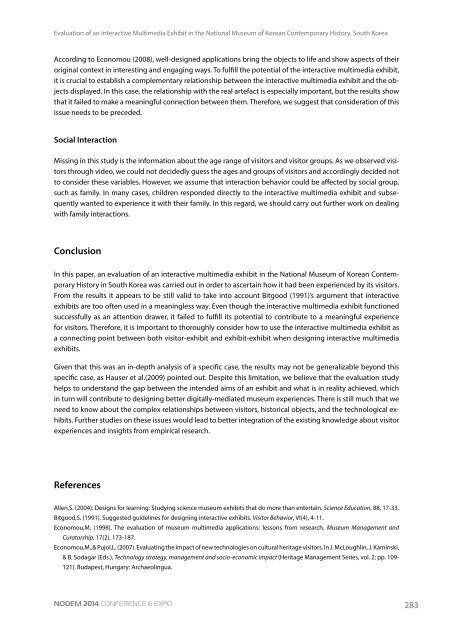NODEM 2014 Proceedings
NODEM 2014 Proceedings
NODEM 2014 Proceedings
You also want an ePaper? Increase the reach of your titles
YUMPU automatically turns print PDFs into web optimized ePapers that Google loves.
Evaluation of an Interactive Multimedia Exhibit in the National Museum of Korean Contemporary History, South Korea<br />
According to Economou (2008), well-designed applications bring the objects to life and show aspects of their<br />
original context in interesting and engaging ways. To fulfill the potential of the interactive multimedia exhibit,<br />
it is crucial to establish a complementary relationship between the interactive multimedia exhibit and the objects<br />
displayed. In this case, the relationship with the real artefact is especially important, but the results show<br />
that it failed to make a meaningful connection between them. Therefore, we suggest that consideration of this<br />
issue needs to be preceded.<br />
Social Interaction<br />
Missing in this study is the information about the age range of visitors and visitor groups. As we observed visitors<br />
through video, we could not decidedly guess the ages and groups of visitors and accordingly decided not<br />
to consider these variables. However, we assume that interaction behavior could be affected by social group,<br />
such as family. In many cases, children responded directly to the interactive multimedia exhibit and subsequently<br />
wanted to experience it with their family. In this regard, we should carry out further work on dealing<br />
with family interactions.<br />
Conclusion<br />
In this paper, an evaluation of an interactive multimedia exhibit in the National Museum of Korean Contemporary<br />
History in South Korea was carried out in order to ascertain how it had been experienced by its visitors.<br />
From the results it appears to be still valid to take into account Bitgood (1991)’s argument that interactive<br />
exhibits are too often used in a meaningless way. Even though the interactive multimedia exhibit functioned<br />
successfully as an attention drawer, it failed to fulfill its potential to contribute to a meaningful experience<br />
for visitors. Therefore, it is important to thoroughly consider how to use the interactive multimedia exhibit as<br />
a connecting point between both visitor-exhibit and exhibit-exhibit when designing interactive multimedia<br />
exhibits.<br />
Given that this was an in-depth analysis of a specific case, the results may not be generalizable beyond this<br />
specific case, as Hauser et al.(2009) pointed out. Despite this limitation, we believe that the evaluation study<br />
helps to understand the gap between the intended aims of an exhibit and what is in reality achieved, which<br />
in turn will contribute to designing better digitally-mediated museum experiences. There is still much that we<br />
need to know about the complex relationships between visitors, historical objects, and the technological exhibits.<br />
Further studies on these issues would lead to better integration of the existing knowledge about visitor<br />
experiences and insights from empirical research.<br />
References<br />
Allen,S. (2004). Designs for learning: Studying science museum exhibits that do more than entertain. Science Education, 88, 17-33.<br />
Bitgood,S. (1991). Suggested guidelines for designing interactive exhibits. Visitor Behavior, VI(4), 4-11.<br />
Economou,M. (1998). The evaluation of museum multimedia applications: lessons from research. Museum Management and<br />
Curatorship, 17(2), 173-187.<br />
Economou,M.,& Pujol,L. (2007). Evaluating the impact of new technologies on cultural heritage visitors. In J. McLoughlin, J. Kaminski,<br />
& B. Sodagar (Eds.), Technology strategy, management and socio-economic impact (Heritage Management Series, vol. 2; pp. 109-<br />
121). Budapest, Hungary: Archaeolingua.<br />
<strong>NODEM</strong> <strong>2014</strong> Conference & Expo<br />
283


